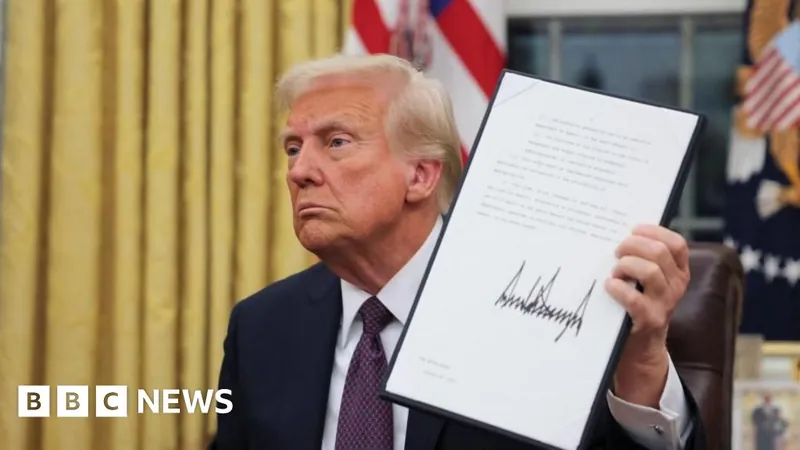
Canada Dodges Trump's Tariff Bullet, But for How Long?
2025-01-21
Author: William
Introduction
In a tense climate where trade relations hang by a thread, Canada has managed to dodge the tariffs that President Donald Trump threatened to impose as soon as he took office. This temporary relief, however, may only be a brief pause before a potentially dangerous escalation of a trade war with the U.S.
Trump’s Tariff Threats
On Monday, Trump indicated that he may impose tariffs of 25% on imports from Canada and Mexico as early as February 1, triggering an urgent review of trade practices with these neighboring countries, alongside China. His administration has pledged a sweeping approach to tariffs, proposing 10% on all global imports and a staggering 60% on Chinese goods in an effort to bolster the American economy.
Canada’s Response
Canadian Prime Minister Justin Trudeau responded with caution. He reaffirmed that if tariffs were enacted, Canada would retaliate, insisting that "everything is on the table." Canadian officials, while relieved by the current hold on tariffs, remain on high alert as the threat looms ominously overhead.
The Stakes for Canada
With approximately 75% of Canada's exports directed towards the United States, the stakes are incredibly high. Trudeau addressed the unpredictability expected from the Trump administration, emphasizing Canada's role as a stable and essential trading partner. He highlighted that Canada supplies vital commodities, including energy and critical minerals, crucial for the American economy's continued growth.
Impact of Tariffs on Trade Relations
The reasoning behind Trump’s tariff threats is twofold: to pressure Canada and Mexico into tackling illegal immigration and drug smuggling issues. Canada's Foreign Minister Melanie Joly has cautioned that these tariffs could ignite a "historic trade war," with Ottawa poised to enact countermeasures that could amount to billions of dollars in retaliatory tariffs.
Trudeau’s Strategic Positioning
Moreover, Trudeau has endorsed a "dollar-for-dollar matching" tariff principle, a strategy intended to fortify Canada’s position if push comes to shove. As talks intensify, Trudeau’s cabinet is convening in Quebec to deliberate on the U.S.-Canada relationship, emphasizing the economic benefits of their robust trading ties, which amounted to an impressive $909 billion in 2022.
Historical Context
Trump's first term saw the renegotiation of a trilateral free trade agreement that includes Canada and Mexico. However, a recent presidential memo has widened the scope of inquiry into how this deal impacts American workers, prompting a review that’s due by April 1.
Concerns and Countermeasures
Interestingly, while there are concerns about illegal activities across U.S. borders, statistics reveal that unlawful crossings and drug seizures at the Canadian border are significantly lower than those stemming from the Mexico border. This nuance has raised questions about the rationale behind the punitive tariffs Trump threatens.
Canada's Commitment to Security
In a bid to fortify border security, Canada has committed to implementing C$1.3 billion worth of measures, including enhanced surveillance and the formation of a joint task force targeting organized crime.
Economic Implications of Tariffs
With tariffs being a cornerstone of Trump’s economic strategy—aimed at driving job growth and raising tax revenue—experts warn that the backlash could lead to increased prices for American consumers and considerable pain for businesses facing international retaliation.
Conclusion
As the situation continues to evolve, all eyes will be on Canada and how it prepares to navigate this challenging landscape in the months ahead. Will Trudeau's government find a way to mitigate the impending trade storm, or are we witnessing just the beginning of a tumultuous economic battle? Stay tuned!









 Brasil (PT)
Brasil (PT)
 Canada (EN)
Canada (EN)
 Chile (ES)
Chile (ES)
 Česko (CS)
Česko (CS)
 대한민국 (KO)
대한민국 (KO)
 España (ES)
España (ES)
 France (FR)
France (FR)
 Hong Kong (EN)
Hong Kong (EN)
 Italia (IT)
Italia (IT)
 日本 (JA)
日本 (JA)
 Magyarország (HU)
Magyarország (HU)
 Norge (NO)
Norge (NO)
 Polska (PL)
Polska (PL)
 Schweiz (DE)
Schweiz (DE)
 Singapore (EN)
Singapore (EN)
 Sverige (SV)
Sverige (SV)
 Suomi (FI)
Suomi (FI)
 Türkiye (TR)
Türkiye (TR)
 الإمارات العربية المتحدة (AR)
الإمارات العربية المتحدة (AR)